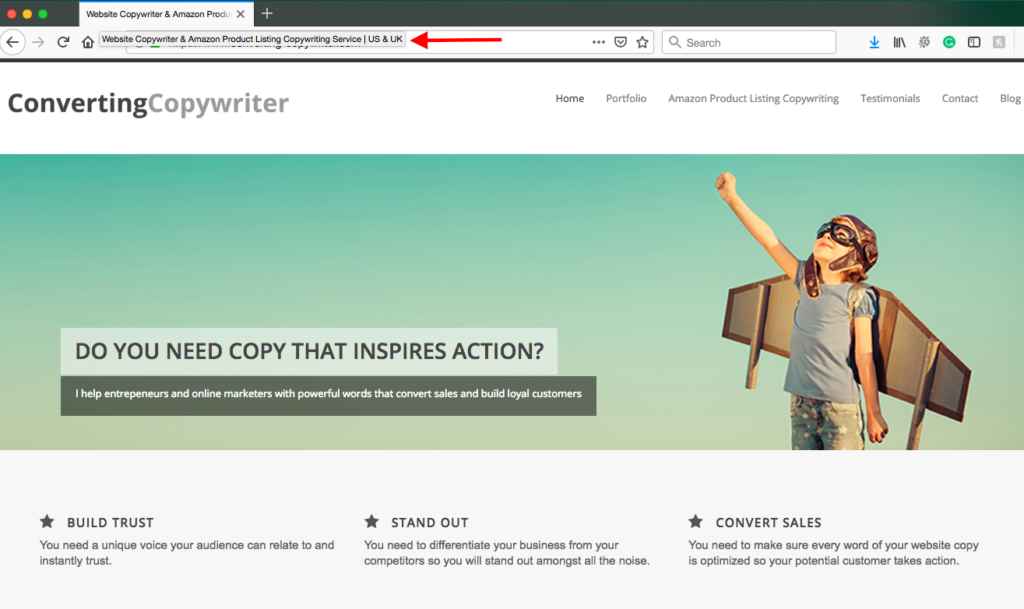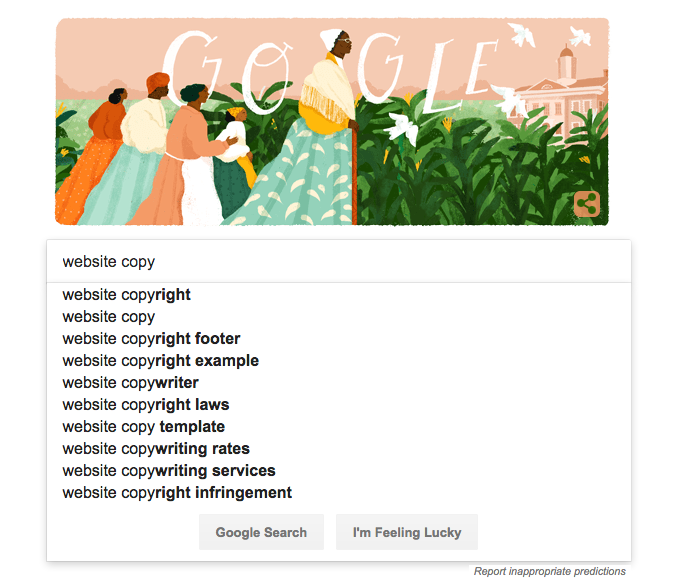I am often asked how to rank higher on Google and increase organic traffic on a website using SEO. Basically, it’s all about targeting the right keywords through good research, and then placing those search terms naturally throughout your marketing copy and website content.
It’s not rocket science – you can do this!
Firstly, I’ll say that this element of online marketing is pretty simple to understand and implement. Sure, there are SEO experts that know a lot about the algorithms of Google or Amazon, but you can get pretty far by yourself.
Competitor research
The first place to find keyword ideas is to look at what your competitors are doing.
Make a list of your top 5 competitors (you don’t need any more than this).
Go onto their websites and make a list of what page titles they are using. You can do this by clicking or hovering over the tab at the top of the browser window.

For example, my website’s homepage title is:
Website Copywriter & Amazon Listing Copywriting Service | US & UK
This is jam-packed with single keywords that make up the major search terms that my target audience use to find my service, so it’s super optimized.
Also, by including those words in this blog in a way that makes sense, it will help reinforce to Google that my website should be ranked for these terms. But more on that later…
After you’ve listed out your competitors’ page titles, scour the copy on their main pages for potential search terms and add them to your list. Hover your mouse over their images, or open them in a new tab to see how they are labeled. You are sure to find more keywords there too.
Find out what metatags your competitors are using by right clicking anywhere on the page and selecting ‘view source’.
Once you have your list of competitor keyword phrases, you should already have a good picture of what search terms are most popular.
Use the Google search bar
Next, you’re going to use Google’s search bar to expand your list of potential keywords.
1. Open an incognito window, or clear your cache
2. Go to Google.com
3. Take your list of competitor keywords and start typing your major root keywords into the search bar. For example, I might start typing ‘website copy’
You will get something like this:

Google then suggests search terms based on the ones that are most popular (highest volume). So from that list above, I might write down:
Website copywriter
Website copywriting rates
Website copywriting services
All of these show potential ‘intent to buy’.
So, pop in your service or product type and see what Google suggests. Try lots of different terms.
Invest in a great a keyword research tool
You can only get so far with free keyword research tools. You need to know what volume and competition a keyword has, so you know which ones to prioritize and target.
A month’s subscription to a professional keyword research tool that gives you a ton of valuable data will set you back between $30-$40, which is nothing in the grand scheme of your epic business.
I recommend Longtail Pro as the mac daddy of keyword research tools. I use it for both websites and marketplaces, and have had great success for both me and my clients using its powerful data.
With Longtail Pro you can do unlimited searches and build a mega master list of search terms.
The other tool I recommend for Amazon sellers is Helium10. It is THE best tool for spying on your competitors, finding golden keyword opportunities and keeping track of your listing’s performance. They also have a ton of video tutorials.
Prioritize your list
Once you have a master list, you need to drill it down according to the following factors:
1. Relevance
2. Intent to buy (product or service)
3. High volume & low competition
The third one can be tough in a competitive market, so see if you can find some keyword opportunities that you could potentially target. Longtail keywords often provide these opportunities. For example:
Website copywriter – volume 1000k p/m – competition HIGH
Website copywriting service UK – volume 250 p/m – competition LOW
If I’m late to the market, there’s no way I’m going to rank for the main root term (unless I drive traffic in other ways). But I have a shot at the longtail search term that has lower volume, but also lower competition.
Optimize your content & website with your keywords
So now you have your targeted master keywords list and you’re ready to start optimizing your content.
Here’s where you need to put your search terms:
– Page titles
– Section headers
– Image file names and captions
– Metatags
– Body text of any content
If you have long keyword search terms that can’t fit naturally in a sentence, just place the single keywords that make up the term throughout your content and you can still rank for that term.
Basically, when you’re writing about your product, service or company, try and phrase it in a way that allows you to naturally include your keywords. This is the most challenging bit, because you also need rich marketing copy.
Of course, you could always hire a professional copywriter to do it for you.
See what I did there?
Attracting your ideal customer
Beyond optimizing your website, another great way to attract your target audience to your website (and to your buy/contact buttons) is with blogs and social media posts.
Create blogs that answer or solve your customers’ problems so you can include links to your product or service, or a key Call to Action, while they are on the page (like the big blue box on your right!).
You can find what problems or questions your customers have by going back to your early master keyword list and looking at searches that include terms like ‘how to…’ or ‘what is…’ or ‘where can I find…’
Create an SEO blog title that includes their question and write 500-1000 words of valuable content that provides some insight or solves their problem.
Then distribute that blog link on all of your social media channels and include relevant hashtags to your market space, in order to reach a wider audience.
So in conclusion, it’s all about putting the right words in the right places!
Follow me on social to be notified of future blogs where I’ll share more ideas on how to increase traffic to your website.
—————-
WANT HELP ATTRACTING TARGETED TRAFFIC TO YOUR WEBSITE?
